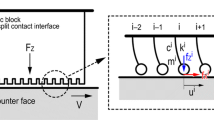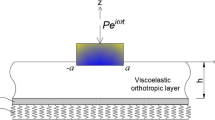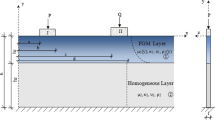Abstract
Rubber material is an excellent cushioning material in daily life and engineering applications. In this paper, the influence of rubber combination types and the corrugated surface roughness on cushioning performance are analyzed. By controlling the friction coefficients at different positions, the influence on the cushioning performance is also explored. Solving the numerical instability and energy nonconservation that are prone to occur in collisions is crucial for the accuracy of numerical simulation. The complexities of collision solution are overcome by separating nonlinear factors. The dynamics equation is derived according to the principle of virtual displacement, the geometric nonlinear problem of materials is described by the total Lagrangian formulation. Under the bipotential framework, the boundary nonlinear problem is solved based on the complete contact law. To reduce the solution cost and to improve the numerical accuracy, the prediction-correction step is used to solve the collision force. The bipotential coefficient is automatically updated with time steps, without the need for manual adjustment by users, achieving better convergence. Then, the collision force is substituted into the dynamic equation in the form of external load, which will not increase the degrees of freedom, and has better numerical robustness. In addition, the Newton–Raphson iterative method is embedded in the Tamma–Namburu scheme to solve the material nonlinearity problem and improve the numerical stability. Several numerical examples are presented to demonstrate the effectiveness of the proposed algorithm in the simulation of collision problems. Moreover, the proposed algorithm is proved to be stable and strictly satisfy the law of energy conservation/dissipation. Even for the corrugated surface structure with nonuniform friction, it can also better complete simulating the collision process.





















Similar content being viewed by others
References
Hubbard, P.M.: Collision detection for interactive graphics applications. IEEE Trans. Vis. Comput. Graph. 1(3), 218–230 (2018)
Nurkertamanda, D., Frendiansyah, F., Saptadi, S., et al.: Virtual laboratory application based on virtual reality simulation as training tool of turning machine using goal-directed design method. IOP Conf. Ser., Mater. Sci. Eng. 1072(1), 012077 (2021)
Zhu, X., Qian, Y., Wang, Q., et al.: Collision-aware interactive simulation using graph neural networks. Vis. Comput. Ind. Biomed. Art 5(1), 1–13 (2022)
Pagaimo, J., Millan, P., Ambrósio, J.: Flexible multibody formulation using finite elements with 3 DoF per node with application in railway dynamics. Multibody Syst. Dyn. 58(1), 83–112 (2023)
Shadi, A., Ahmadihosseini, A., Rabiei, M., et al.: Numerical and experimental analysis of fully coupled electromagnetic and thermal phenomena in microwave heating of rocks. Miner. Eng. 178, 107406 (2022)
Wang, R., Zha, W.H.: Numerical simulation study of anti-large deformation bolt structure. J. Phys. Conf. Ser. 2185(1), 012060 (2022)
Yu, S., Ren, X., Zhang, J., et al.: An improved form of smoothed particle hydrodynamics method for crack propagation simulation applied in rock mechanics. Int. J. Min. Sci. 31(3), 421–428 (2021)
Wang, B., Fan, X.: Ground flutter simulation test based on reduced order modeling of aerodynamics by CFD/CSD coupling method. Int. J. Appl. Mech. 11(1), 1950008 (2019)
Fromreide, M., Hansen, A.: Predicting motion patterns using optimal paths. Front. Phys. 9, 656296 (2021)
Guo, Q., Yu, W., Hao, F., et al.: Modelling and analysis of adaptive cruise control system based on synchronization theory of Petri nets. Electronics 11(21), 3632 (2022)
Li, G., Zuo, H., Xu, J.: Research on the influence of UAV anti-collision device on aerodynamic shape. J. Phys. Conf. Ser. 2477(1), 012096 (2023)
Elkady, M., Elmarakbi, A., Crolla, D.: Simulation of a multibody occupant model during vehicle collision with different applications of vehicle control systems. Proc. Inst. Mech. Eng., Proc., Part K, J. Multi-Body Dyn. 226(3), 220–244 (2012)
Maier, S., Fehr, J.: Efficient simulation strategy to design a safer motorcycle. Multibody Syst. Dyn. (2023)
Liu, J., Sun, B.S., Cao, J.N.: Structural optimization design of anti-collision sealing cylindrical rubber cushion. Appl. Mech. Mater. 201, 894–897 (2012)
Haddout, A., Fahoume, M., Raidou, A., et al.: Numerical modeling of ZnSnO/CZTS based solar cells. Optoelectron. Lett. 18(5), 276–282 (2022)
Dalisay, J.D.E., Liu, L., Eriten, M., et al.: Characterization of visco-hyperelastic behavior of open cell polyurethane foam through transient shear testing. Int. J. Solids Struct. 241, 111482 (2022)
Alemdar, F., Ahmed, F.: Validation of an elastomeric bearing characterized with finite element hyperelastic models. European Journal of Science and Technology 27, 471–478 (2021)
Yao, S., Li, Z., Ma, W., et al.: Experimental investigation of the quasi-static and impact tests on the energy absorption characteristics of coupler rubber buffers used in railway vehicle. Proc. Inst. Mech. Eng., F J. Rail Rapid Transit 233(9), 937–950 (2019)
Golovanov, A.I., Konoplev, Y.G., Sultanov, L.U., et al.: Numerical investigation of large deformations of hyperelastic solids: II. Stress-strain relationships. Proc. Inst. Uchenye Zapiski Kazanskogo Universiteta. Seriya Fiziko-Matematicheskie Nauki. 150(3), 122–132 (2008)
Kshirsagar, S., Lee, C., Natarajan, S.: \(\alpha \)-finite element method for frictionless and frictional contact including large deformation. Int. J. Comput. Methods 18(7), 2150002 (2021)
Mondal, P., Arunachalam, S.: Finite element modelling of car seat with hyperelastic and viscoelastic foam material properties to assess vertical vibration in terms of acceleration. Engineering 12(3), 177–193 (2020)
Zhou, R.L., Zhang, Q.F., Bi, X.Q., et al.: Dynamics characteristic research on impact strength and cushion of rubber part. J. Mech. Strength 37(3), 582–586 (2015)
Ahmed, N., Xue, P.: Determination of the size of the local region for efficient global/local modeling in a large composite structure under impact loading. Int. J. Impact Eng. 144, 103646 (2020)
Chatterjee, A., Bowling, A.: Modeling three-dimensional surface-to-surface rigid contact and impact. Multibody Syst. Dyn. 46(1), 1–40 (2019)
Hirmand, M., Vahab, M., Khoei, A.R.: An augmented Lagrangian contact formulation for frictional discontinuities with the extended finite element method. Finite Elem. Anal. Des. 107, 28–43 (2015)
Bozorgmehri, B., Yu, X., Matikainen, M.K., et al.: A study of contact methods in the application of large deformation dynamics in self-contact beam. Nonlinear Dyn. 103, 581–616 (2021)
Chamekh, M., Latrach, M.A., Renard, Y.: Frictional self-contact problem of elastic rods. J. King Saud Univ., Sci. 32(1), 828–835 (2020)
Kikuchi, N., Oden, J.T.: Contact Problems in Elasticity: A Study of Variational Inequalities and Finite Element Methods. SIAM, Philadelphia (1988)
Han, W.M., Migórski, S., Sofonea, M.: On penalty method for unilateral contact problem with non-monotone contact condition. J. Comput. Appl. Math. 356, 293–301 (2019)
Xu, Q.P., Liu, J.Y., Qu, L.Z.: Dynamic modeling for silicone beams using higher-order ANCF beam elements and experiment investigation. Multibody Syst. Dyn. 46, 307–328 (2019)
Yu, C.X., Jing, D.H., Fu, C., et al.: A kind of FM-BEM penalty function method for a 3D elastic frictional contact nonlinear system. J. Math-Uk. 8, 6626647 (2021)
Bertsekas, D.P.: Constrained Optimization and Lagrange Multiplier Methods. Academic Press, San Diego (2021)
Chen, X., Cui, M.Q.: Dynamic modeling and analysis of 4UPS-UPU spatial parallel mechanism with spherical clearance joint. J. Harbin Inst. Tech. 28(3), 61–78 (2021)
Tomec, J., Jelenić, G.: Analysis of static frictionless beam-to-beam contact using mortar method. Multibody Syst. Dyn. 55(3), 293–322 (2022)
Wriggers, P., Simo, J.C.: A note on tangent stiffness for fully nonlinear contact problems. Commun. Appl. Numer. Methods 1(5), 199–203 (1985)
Wu, W., Yang, Y., Zheng, H., et al.: Numerical manifold computational homogenization for hydro-dynamic analysis of discontinuous heterogeneous porous media. Comput. Methods Appl. Mech. Eng. 388, 114254 (2022)
Passas, P., Natsiavas, S.: A time-stepping method for multibody systems involving frictional impacts and phases with persistent contact. Mech. Mach. Theory 169, 104591 (2022)
Moës, N., Béchet, E., Tourbier, M.: Imposing Dirichlet boundary conditions in the extended finite element method. Int. J. Numer. Methods Eng. 83(7), 1641–1669 (2010)
Mourad, H.M., Dolbow, J., Harari, I.: A bubble-stabilized finite element method for Dirichlet constraints on embedded interfaces. Int. J. Numer. Methods Eng. 69(4), 772–793 (2007)
Ji, H., Dolbow, J.E.: On strategies for enforcing interfacial constraints and evaluating jump conditions with the extended finite element method. Int. J. Numer. Methods Eng. 61(14), 2508–2535 (2004)
Cui, Y., Ding, C., Li, X., et al.: Augmented Lagrangian methods for convex matrix optimization problems. J. Oper. Res. Soc. China 10(2), 305–342 (2021)
Guo, J., He, S.: Convergence of an augmented Lagrange algorithm for nonlinear optimizations with second-order cone constraints. Front. Math. China 17(1), 149–170 (2022)
Zhou, P., Ren, H., Masarati, P.: A relaxed coupling method for algebraically constrained mechanical systems. Multibody Syst. Dyn. 55(1–2), 57–81 (2022)
Wang, Q., Zhang, R., Zheng, X.: Comparison and analysis of two Coulomb friction models on the dynamic behavior of slider-Crank mechanism with a revolute clearance joint. Appl. Math. Mech. 39(9), 1239–1258 (2018)
Xu, Z.X., Wang, Q., Wang, Q.Y.: Numerical method for dynamics of multi-body systems with two-dimensional Coulomb dry friction and nonholonomic constraints. Appl. Math. Mech. 38(12), 1733–1752 (2017)
Yue, J., Liu, G.R., Li, M., et al.: A cell-based smoothed finite element method for multibody contact analysis using linear complementarity formulation. Int. J. Solids Struct. 141, 110–126 (2018)
De Saxcé, G., Feng, Z.Q.: The bi-potential method: a constructive approach to design the complete contact law with friction and improved numerical algorithms. Math. Comput. Model. 28(4–8), 225–245 (1998)
De Saxcé, G., Feng, Z.Q.: New inequality and functional for contact with friction: the implicit standard material approach. Mech. Struct. Mach. 19(3), 301–325 (1991)
Tao, L., Li, Y., Feng, Z.Q., et al.: Bi-potential method applied for dynamics problems of rigid bodies involving friction and multiple impacts. Nonlinear Dyn. 106(3), 1823–1842 (2021)
Ning, P., Feng, Z.Q., Quintero, J.A.R., et al.: Uzawa algorithm to solve elastic and elastic-plastic fretting wear problems within the bi-potential framework. Comput. Mech. 62(6), 1327–1341 (2018)
Hu, L.B., Cong, Y., Renaud, C., et al.: A bi-potential contact formulation of orthotropic adhesion between soft bodies. Comput. Mech. 69(4), 931–945 (2022)
Chen, H., Feng, Z.Q., Tao, L., et al.: On the emergence of the second harmonic shear horizontal wave in presence of tangential prestress. J. Sound Vib. 557, 117732 (2023)
Feng, Z.Q., Feng, Z.G.: FER/View: An Interactive Finite Element Post-Processor. The Word Congress on Computational Mechanics, WCCM VI in Conjunction with APCOM04. Springer, Beijing (2004)
Blatz, P.J., Ko, W.L.: Application of finite elastic theory to the deformation of rubbery materials. J. Rheol. 6(1), 223–252 (1962)
Wriggers, P.: Nonlinear Finite Element Methods. Springer, New York (2008)
Armero, F., Petőcz, E.: Formulation and analysis of conserving algorithms for frictionless dynamic contact/impact problems. Comput. Methods Appl. Mech. Eng. 158(3–4), 269–300 (1998)
Jean, M.: Dynamics with partially elastic shocks and dry friction: double scale method and numerical approach. In: Proceedings of the 4th Meeting on Unilateral Problems in Structural Analysis. Capri (1989)
Tamma, K.K., Namburu, R.R.: A robust self-starting explicit computational methodology for structural dynamic applications: architecture and representations. Int. J. Numer. Methods Eng. 29(7), 1441–1454 (2010)
Öchsner, A., Öchsner, M.: A First Introduction to the Finite Element Analysis Program MSC MARC/MENTAT. Springer, Singapore (2018)
Kuhl, D., Crisfield, M.: Energy-conserving and decaying algorithms in non-linear structural dynamics. Int. J. Numer. Methods Eng. 45(5), 569–599 (1999)
Author information
Authors and Affiliations
Contributions
Ling Tao wrote the main manuscript text, and prepared all figures. (Data curation: Lead; Formal analysis: Lead; Investigation: Lead; Methodology: Lead; Project administration: Lead; Software: Lead; Validation: Lead; Visualization: Lead; Writing – original draft: Lead; Writing – review & editing: Lead) Zhiqiang Feng provided internal visualization software and guidance on software operation and related numeical method. All authors reviewed the manuscript
Corresponding author
Ethics declarations
Competing interests
The authors declare no competing interests.
Additional information
Publisher’s Note
Springer Nature remains neutral with regard to jurisdictional claims in published maps and institutional affiliations.
Rights and permissions
Springer Nature or its licensor (e.g. a society or other partner) holds exclusive rights to this article under a publishing agreement with the author(s) or other rightsholder(s); author self-archiving of the accepted manuscript version of this article is solely governed by the terms of such publishing agreement and applicable law.
About this article
Cite this article
Tao, L., Feng, Z. Cushioning performance analysis of multilayered rubber materials with nonuniform friction coefficients of corrugated contact surface under the bipotential framework. Multibody Syst Dyn (2023). https://doi.org/10.1007/s11044-023-09931-7
Received:
Accepted:
Published:
DOI: https://doi.org/10.1007/s11044-023-09931-7




